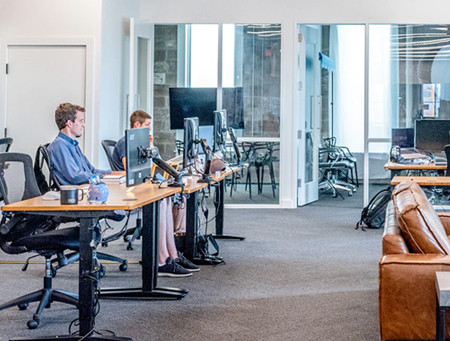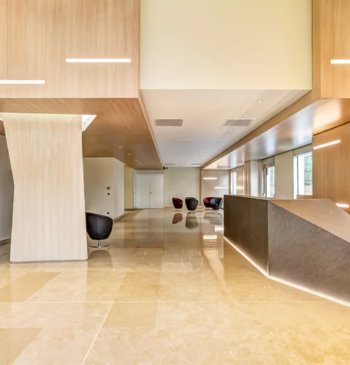25 Nov


For remote work, you know what the drill is.
Individual work is a breeze. Employees enjoy that they can cut down on commute time and work within the privacy and freedom of their homes. Their productivity and family time can increase by an encouraging measure.
But collaborative work suffers. People who need to piece together a complex process of work in unison with their colleagues will have their results lag. Communication, camaraderie, and alignment are essential aspects of teamwork—one’s goal must meet the other’s goal.
That is one reason why work is now transitioning back to the workplace, regardless of the benefits of remote work. The second reason is mental health: there is “pandemic fatigue” which is a combination of loneliness, no regular social interaction, unaired misgivings, and other cumulative problems. Employees just want to return to normal!
As we move back to workplaces, organizations and their leaders are looking to technological solutions to making the transition smooth, all while maintaining public health. Here are five critical approaches to make this transition safe and efficient, moving forward into 2021 and beyond.
1. Reduce Touchpoints with Touchless Visitor Management Systems:
All workplaces have a “front desk entry workflow.” What does this mean in simpler terms? When people enter the workplace, they must adhere to certain protocols. Most workplaces will have a security guard, receptionist, and an entry logbook. However, this traditional workflow leaves many opportunities for contact between people, and this is unnecessary in the era of smart devices.
Looking forward, workplaces need to reduce touchpoints by incorporating the use of technology in the form of self-service kiosks, biometric scanners, and contactless card readers. Workplaces can go one step further by designing the entire entry-to-exit workflow for all the people inside. Room occupancy can be limited, meeting rooms scheduled, and more. What can manage all of this? A visitor authentication and management system (VAMS), which is usually software as a service (SaaS). Best of all, it can create a slick workflow whose elements convey a sense of professional gravitas to the workplace, impressing customers and clients.
2. Harness Popular Technology Used by All
Anyone contemplating what the workplace will look like in the post-pandemic needs to understand that workplace tech and user experience remains critical. And the most important point of all is technology most people are familiar with nowadays: smartphones, tablets, and their many apps!
A VAMS runs on smartphones, tablets, PCs, and more. And it is integratable with the access control system (ACS) technologies mentioned above: kiosks, flap barriers, electromagnetic locks, etc. This eliminates the need for logbooks and receptionists. QR codes, automated emails, and text messages can help authenticate the visitors coming in. Mobile apps play a significant role by their adaptability to various uses. Companies can explore app prototypes that can manage entry, exit, attendance, health screening questionnaires, desk bookings, and work schedules.
3. Make Super-Accessible Paperless Records
Logbooks, ledgers, and other paper records cover a large amount of space in the workplace. While this mode of record keeping is phasing out, workplaces—especially large ones—should look to accelerate the change wherever they can and as fast as possible. For large enterprises, the front desk entry workflow is massive. It processes large daily volumes of people, whose records could be utilized for functions like reports, payroll, compliance, insurance, and performance analysis. Most saliently, logs are super-accessible from a digital dashboard and can be pulled up within seconds!
4. Integrate Different Technologies for Efficiency
Seamless interfaces save time, money, and mental comfort. Modern VAMS technologies shouldn’t overcomplicate your IT environment but rather integrate with the pre-established workplace systems. When workplaces integrate VAMS technology to ACS technology, the result is marvelous. Marrying security to hospitality is what makes a complete workplace. Managers can receive an overarching view on the whole organization and use it for actionable insights.
5. Workplace Tech That’s Easy to Update
Workplaces generally make the mistake of sacrificing progress for convenience. Do not fixate on a software solution or technology that is easy to use. Rather, use solutions that have potential for evolution into the future, ones that are seamlessly updatable. Whenever you add on new features, improvements, or updates, they must not create downtime. What are examples of updates that you might need in the future? Customized workflows for client, contractors, and workforce journeys. Providing information such as geolocations, maps, technical instructions, and explainer videos into meeting invites. The possibilities are endless.
VAMS technologies can play a powerful role in keeping the post-pandemic era secure, safe, efficient, and seamless. By integrating access control with visitor management, perpetuating contactless user experiences, and designing customized workflows, organizations can instill confidence in their people, proving that the workplace is still a necessary hub for human innovation.

Subscribe to our Newsletter
HEAD OFFICE
VAMS Safeguard Pvt. Ltd.
+91 22-4170-7575 [email protected]C-209/210, Mittal Commercia Premises Co. Op. Soc. Ltd., Near Mittal Estate, Andheri East, Mumbai – 400059
HEAD OFFICE
Suite 1902, 1212, Avenue Of the Americas, New York, NY 10036
© 2025 by VAMS GLOBAL.





